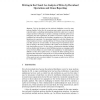Free Online Productivity Tools
i2Speak
i2Symbol
i2OCR
iTex2Img
iWeb2Print
iWeb2Shot
i2Type
iPdf2Split
iPdf2Merge
i2Bopomofo
i2Arabic
i2Style
i2Image
i2PDF
iLatex2Rtf
Sci2ools
DIMVA
2013
2013
Driving in the Cloud: An Analysis of Drive-by Download Operations and Abuse Reporting
Drive-by downloads are the preferred distribution vector for many malware families. In the drive-by ecosystem many exploit servers run the same exploit kit and it is a challenge understanding whether the exploit server is part of a larger operation. In this paper we propose a technique to identify exploit servers managed by the same organization. We collect over time how exploit servers are configured and what malware they distribute, grouping servers with similar configurations into operations. Our operational analysis reveals that although individual exploit servers have a median lifetime of 16 hours, long-lived operations exist that operate for several months. To sustain long-lived operations miscreants are turning to the cloud, with 60% of the exploit servers hosted by specialized cloud hosting services. We also observe operations that distribute multiple malware families and that pay-per-install affiliate programs are managing exploit servers for their affiliates to convert tr...
| Added | 28 Apr 2014 |
| Updated | 28 Apr 2014 |
| Type | Journal |
| Year | 2013 |
| Where | DIMVA |
| Authors | Antonio Nappa, M. Zubair Rafique, Juan Caballero |
Comments (0)

